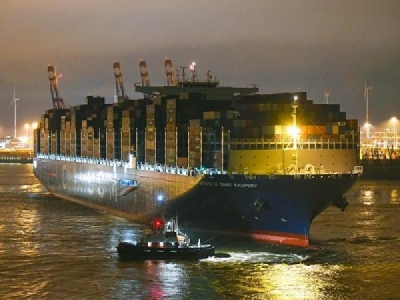
Posted on March 20, 2018
By Greg Knowler, JOC.com
The Port of Hamburg celebrated the largest container ship to ever sail up Germany’s Elbe River, but the arrival of 20,776 TEU CMA CGM Antoine de Saint Exupery also served as another reminder of the urgent need to deepen river access to the North Europe hub.
On its maiden call to Hamburg with the FAL1 service between Asia and Europe, the biggest ship in the CMA CGM fleet is currently discharging 7,000 TEU and loading 4,000 TEU at Hamburger Hafen unk Logistik AG (HHLA) Container Terminal Burchardkai.
Hub ports handling mega-ships is not unusual, and the Port of Hamburg certainly has the infrastructure required to compete with its regional peers, but the difference is that even though Germany’s busiest port doubled the number of mega-ships it handled in 2017 to 102 calls, its throughput actually declined compared with the previous year. And this in a year when all its hub competitors in North Europe reported strongly rising volume.
Port of Hamburg Marketing officials believe draft restrictions in force on the Elbe River fairway and the narrow tidal window have caused shipowners to use available transport space on their mega-ships primarily to shift loaded boxes, with empty containers increasingly being routed via other ports in North Europe.
In 2017, the empty containers handled by Hamburg fell by 88,000 TEU to 1.2 million TEU, while loaded boxes remained unchanged at 7.6 million TEU. Hamburg handles the lowest proportion of empty containers among its hub peers at 13 percent of the total, and the highest proportion of loaded boxes at 87 percent.
“Once the Elbe fairway adjustment has been completed, we shall be able to handle substantially more containers and bulk cargo in Hamburg. Terminals and other port facilities are well prepared for growth,” said Port of Hamburg Marketing executive board member Ingo Egloff.
Hamburg is confident a start on the deepening work will finally be made this year. Environmental opposition to deepening the Elbe River has been holding up plans to dredge about 130 kilometers (81 miles) of the river that, once complete, will enable the mega-ships with a draught of 14.5 meters (47.6 feet) to reach the port, one meter deeper than the current draught. But in November 2017, a German court dismissed a legal challenge to the planned dredging, clearing the way for the project.
Burchardkai has been designed to handle the mega-ships with two berths for handling 20,000-plus TEU vessels and gantry crane booms extending over the 24 boxes that comprise a mega-ship row. Nine of the 13 cranes are being used simultaneously to handle the CMA CGM Antoine de Saint Exupery.
“By investing in state-of-the-art gantry cranes and storage technology, we prepared ourselves at an early stage for this growth in ship size,” said Jens Hansen, HHLA executive board member and chief operating officer.
But he noted that the port was not only making progress on the quayside. In November 2017 a slot booking procedure for trucks was introduced to overcome peak situations, and the expansion of the Altenwerder rail terminal and the Burchardkai rail terminal will further integrate Hamburg with European hinterland rail services.
Port officials believe that the growth in container shipping vessel size has reached its limit or will only continue in small steps, and with 98 percent of all cargo moving through the port now in containers, the new focus at Hamburg will be on how to optimize the handling of those boxes through technology, innovation, and digitalizing many of the processes in the port.
Source: JOC.com





